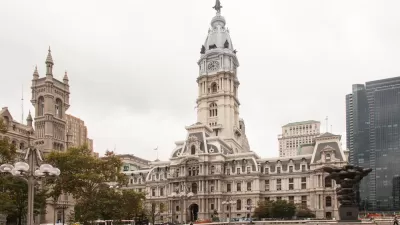After decades of promises of improvements along the Delaware River In Philadelphia with little to show for it, recent "small but powerful" public improvements are remaking the city's waterfront into a "welcoming, fun place to hang out."
"The Nutter administration has just checked off two more items on its waterfront to-do list: FringeArts' seductive new culture hub at Race Street, which officially debuts its restaurant today, and the lush Washington Avenue Green, a reclaimed pier that opened as a park in late August," reports Inga Saffron. "Meanwhile, Spruce Street Harbor Park, a pop-up beer garden and boardwalk combo, proved so popular this summer that its rainbow-colored hammocks were worn to shreds and had to be replaced."
Saffron notes that the waterfront still has a long way to go to deliver larger projects, such as a proposed I-95 cap park between Downtown and Penn's Landing. Yet she writes, "give Nutter a hand for doing something no recent mayor has tried: sticking with the plan. Rather than concoct distracting side deals with developers, in the style of former Mayors Ed Rendell and John Street, Nutter has allowed planners and the Delaware River Waterfront Corp. to set the pace."
FULL STORY: Changing Skyline: A new wave on the Delaware waterfront

Trump Administration Could Effectively End Housing Voucher Program
Federal officials are eyeing major cuts to the Section 8 program that helps millions of low-income households pay rent.

Planetizen Federal Action Tracker
A weekly monitor of how Trump’s orders and actions are impacting planners and planning in America.

The 120 Year Old Tiny Home Villages That Sheltered San Francisco’s Earthquake Refugees
More than a century ago, San Francisco mobilized to house thousands of residents displaced by the 1906 earthquake. Could their strategy offer a model for the present?

HSR Reaches Key Settlement in Northern California City
The state’s high-speed rail authority reached an agreement with Millbrae, a key city on the train’s proposed route to San Francisco.

Washington State Legislature Passes Parking Reform Bill
A bill that would limit parking requirements for new developments is headed to the governor’s desk.

Missouri Law Would Ban Protections for Housing Voucher Users
A state law seeks to overturn source-of-income discrimination bans passed by several Missouri cities.
Urban Design for Planners 1: Software Tools
This six-course series explores essential urban design concepts using open source software and equips planners with the tools they need to participate fully in the urban design process.
Planning for Universal Design
Learn the tools for implementing Universal Design in planning regulations.
Ada County Highway District
Clanton & Associates, Inc.
Jessamine County Fiscal Court
Institute for Housing and Urban Development Studies (IHS)
City of Grandview
Harvard GSD Executive Education
Toledo-Lucas County Plan Commissions
Salt Lake City
NYU Wagner Graduate School of Public Service




























